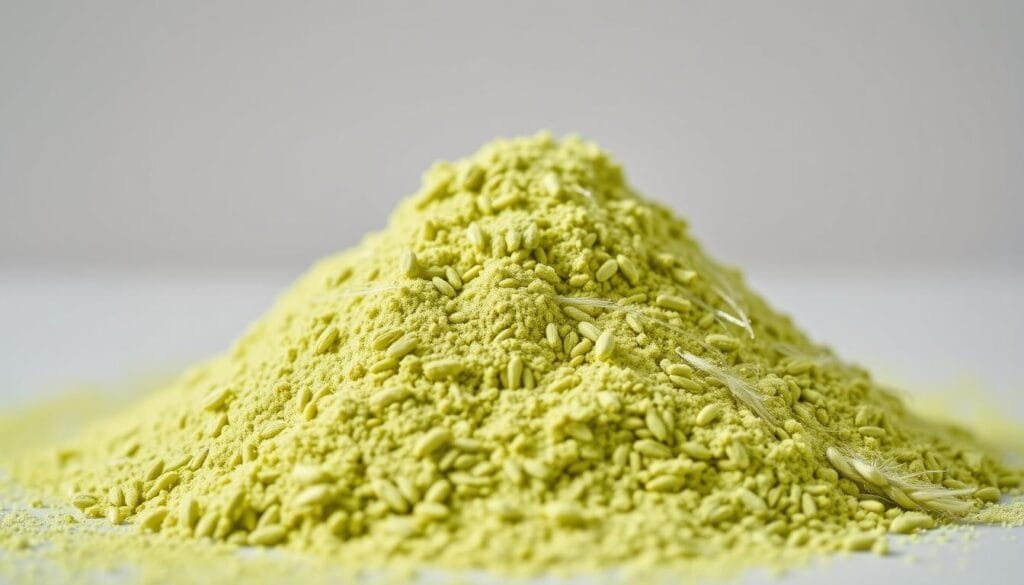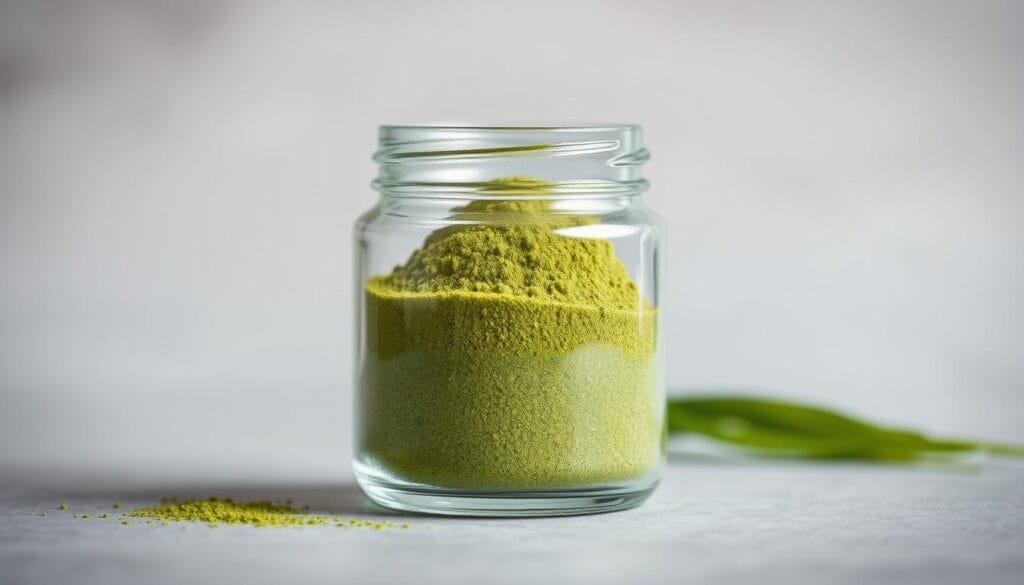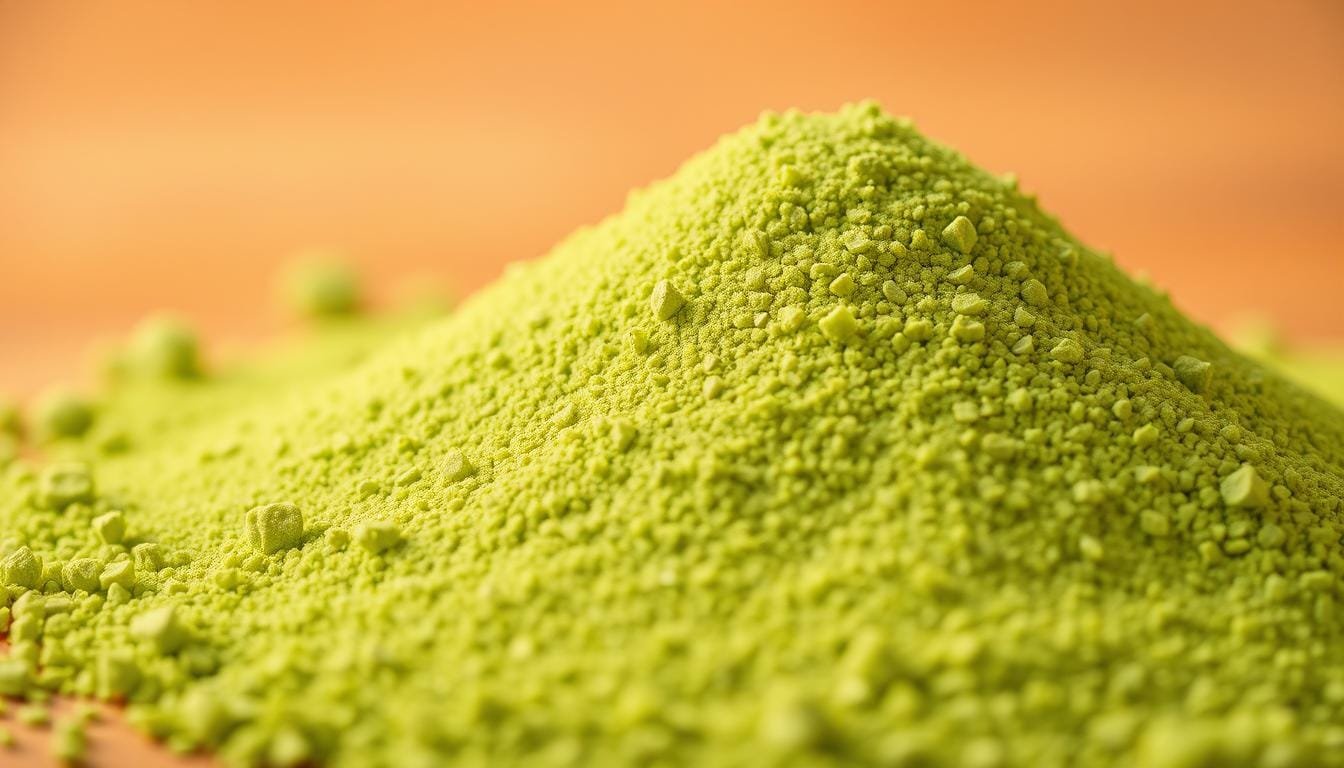Currently Empty: RM0.00
Nearly 3 grams of fiber in a single tablespoon of dried barley grass makes it a surprising powerhouse for quick nutrition on the go.
In Malaysia, this green option now appears in juice bars and health stores beside kale and wheatgrass, signaling growing mainstream interest.
Wellness Concept introduces a trusted barley grass powder designed for busy city routines. The powder delivers key vitamins A, C and K, polyphenols and flavonoids that act as antioxidants.
People who want practical diet support find a powder format easy to mix into smoothies or water. Wellness Concept guides shoppers by WhatsApp at +60123822655 during business hours: Mon-Fri 9:30 am-6:30 pm; Sat-Sun 10 am-5 pm.
This article previews the science-backed benefits, simple serving ideas, safe intake tips, and smart shopping advice so readers can use barley grass food supplement products safely and enjoyably.
Key Takeaways
- Barley grass powder is nutrient-dense and easy to add to daily routines.
- It supplies fiber, vitamins, and antioxidant compounds for everyday support.
- Powder form suits busy lifestyles across Malaysia’s urban areas.
- Wellness Concept offers friendly guidance via WhatsApp and clear business hours.
- The article will cover benefits, recipes, dosage, and product selection.
Why Malaysians Are Turning to This Green Superfood Now
Urban shoppers and busy families are choosing a mild-tasting green powder because it fits fast schedules and simple routines.
Young barley leaves are harvested before seed formation and processed into a bright, nutrient-rich powder. It mixes easily into water, juice, or smoothies for a quick boost of vitamins and fiber.
Practical convenience drives interest: a scoop at home, the office, or after exercise makes daily nutrition less fussy. Many people find this gentle option helps digestion and steady energy without major diet changes.
- Fits plant-forward habits and warm Malaysian days — chilled green drinks are refreshing.
- Works for busy professionals, active users, and families starting simple wellness steps.
- Social sharing and juice-counter visibility have made it a familiar choice.
For local guidance on taste and serving sizes, shoppers can message Wellness Concept via WhatsApp at +60123822655 during business hours.
Top Health Benefits of Barley Grass Backed by Research
Research and nutrient data show clear ways this green powder can support blood sugar, heart health, and digestion. The evidence highlights practical effects when the powder is used alongside healthy habits.
Balances blood sugar
Soluble and insoluble fiber slow carbohydrate absorption and support insulin response. That helps steady daily energy and maintain healthy glucose levels.
Supports heart health
Antioxidants like polyphenols and flavonoids work with potassium and GABA to reduce oxidative stress. Older trials also found reduced LDL oxidation after short-term extract use, a useful marker for heart risk.
Weight management and digestion
Low calories and meaningful fiber can help with weight strategies when paired with mindful eating.
Prebiotic fiber feeds good gut bacteria and eases regular digestion for the whole body.
Immune, bone and energy support
Vitamins A and C help immune response and skin repair, while vitamin K and calcium support bones. Magnesium and amino acids aid energy production and muscle repair.
- Practical note: View the powder as one part of a balanced routine, not a quick fix.
- For specific targets, consult a healthcare professional for tailored guidance.
What’s Inside: The Key Nutrients in Young Barley Leaves
A single scoop of young-leaf powder delivers a compact bundle of key nutrients for everyday support. The leaves are harvested early to lock in vitamins, fiber, and amino acids before the plant shifts energy to seeds.

Vitamins A, C, and K
Vitamins A and C support immune response and skin repair. Vitamin K helps healthy blood clotting and works with calcium for bone maintenance.
Minerals: magnesium, calcium, iron
Magnesium participates in 300+ enzyme reactions and supports energy and glucose control. Calcium and iron assist bone health and oxygen delivery, making the powder a practical, food-based source of minerals.
Fiber and digestion
Dried powder can provide nearly 3 grams of fiber per tablespoon. That compact fiber helps digestion and satiety when added to snacks or beverages.
Antioxidants and protein
Polyphenols and flavonoids act as antioxidants to ease oxidative stress. The leaves also supply complete essential amino acids, so the powder supports plant-based protein needs.
| Nutrient | Primary Role | Typical Benefit |
|---|---|---|
| Vitamins A, C, K | Immune, skin, clotting | Supports defence, repair, and bone maintenance |
| Magnesium & Calcium | Enzyme reactions, bone strength | Energy support and structural health |
| Fiber (~3 g / tbsp) | Digestion & satiety | Improves regularity and fullness |
| Polyphenols & Flavonoids | Antioxidant activity | Reduces oxidative stress |
| Complete amino acids | Protein support | Useful for plant-based diets and recovery |
Note: nutrient content varies by source and processing. For consistent quality, consider trusted powders like barley grass powder and check labeling.
barley grass food supplement: Forms, Products, and Simple Serving Ideas
Choosing the right form depends on taste, time, and kitchen setup. Powder, juice, tablets, and gummies are common products in Malaysia. Powders and juices suit people who want quick nutrient boosts. Tablets and gummies fit those who prefer a no-mix option.
Powder vs. juice — which fits your routine?
Barley grass powder vs. barley grass juice: which fits your routine
Powder is versatile and easy to dose. It mixes into water, juices, or smoothies and works well in chilled drinks. Juice or straight green shots give a bold flavor and fast absorption but need fresh prep or a juice-bar purchase.
Quick ways to add to water, juices, and smoothies
For fast prep, stir a measured scoop into water or fruit juice. Blend 1–2 teaspoons with banana, blueberries, and milk for a simple smoothie.
Creative uses: protein shakes, baked goods, and green blends
Try folding a teaspoon into protein shakes, oats, or yogurt. It also blends subtly into baked goods like zucchini bread for added vitamins and fiber without many extra calories.
“Start small — a teaspoon is a friendly way to test taste and tolerance before increasing the amount.”
| Form | Best for | Typical serving |
|---|---|---|
| Powder | Home smoothies, water mixes | 1–2 teaspoons (about 2–6 grams) |
| Juice / shots | Quick absorption, juice bars | Single shot or 30–60 ml |
| Tablets / gummies | Convenience, travel | Follow product label |
- Pick products with clear ingredients and labels to match taste and convenience.
- Morning servings help build a routine; afternoon blends offer a low-calorie nutrient pick-me-up.
- People tracking amounts can start with a teaspoon and adjust grams as needed.
How Much to Take: Recommended Dosage and Best Timing
Deciding how much to add is simple when readers match goals with a clear daily plan. A practical daily approach is 5–15 grams (about 1–3 teaspoons). Many in Malaysia use this range for steady support of vitamins, minerals, and fiber.
Some people follow a broader safe range of 4–17 grams depending on goals. Measuring by teaspoons makes the serving easy to repeat.
Best timing and gradual increases
Morning or pre-workout servings often feel supportive for energy and can provide a mild boost energy effect. Others prefer a set time with meals to keep diet consistency.
Start low and increase slowly to reduce digestion surprises. Mix the powder in water or blend into smoothies as a quick, reliable way to track amounts and levels.
| Goal | Typical grams | Best time |
|---|---|---|
| Daily maintenance | 5–10 g | Morning with breakfast |
| Energy or pre-workout | 6–12 g | 30–60 minutes before activity |
| Short-term boost or higher intake | 12–17 g | Split servings during the day |
Smart Shopping in Malaysia: Choose Quality Barley Grass Powder
Smart shoppers in Malaysia focus on traceable sourcing and clear labels when picking a green powder. This helps reduce the risk of hidden additives and uneven nutrient content.
Look for organic certification and third-party testing. These checks make it easier to trust the nutrition per serving and the product’s safety.

Check the label for concentration, origin, and short ingredient lists. People who monitor vitamin K or potassium should note amounts per serving and ask a clinician if needed.
Practical buying checklist
- Prefer single-ingredient powder or clearly labelled blends.
- Verify third-party lab reports or batch testing.
- Confirm source and processing to protect antioxidants and vitamins.
- Choose sealed packaging and storage guidance to keep powder fresh for mixing with water.
| What to check | Why it matters | Practical tip |
|---|---|---|
| Organic & third-party tests | Reduces contamination risk | Ask for lab reports or certification |
| Clear ingredient list | Avoids unwanted additives | Pick single-ingredient options when possible |
| Source & concentration | Ensures consistent nutrition | Compare grams per serving on labels |
Wellness Concept offers local, friendly advice and reliable products. Malaysians can WhatsApp +60123822655 during business hours (Mon-Fri 9:30 am-6:30 pm; Sat-Sun 10 am-5 pm) for help comparing options and checking stock.
Tasty, Fast, Nourishing: List of Easy Recipes and Mix-ins
Simple recipe ideas help busy Malaysians add green powder to daily drinks without fuss.
Blueberry-banana smoothie (quick recipe)
Combine 1–2 tsp barley grass powder, 1 banana, 1 cup blueberries, and 1 cup milk. Blend until smooth and serve chilled.
Barley grass juice on its own makes a bright, concentrated shot. Drink it straight, then sip water to refresh the palate.
Easy mix-in ideas that fit local routines:
- Add a teaspoon of grass powder to protein shakes after workouts for extra protein and fiber.
- Mix the powder into overnight oats or yogurt with berries for a chilled breakfast option.
- Swap milk for water or light juices to lower calories while keeping nutrients.
- Fold a small scoop into pancakes, muffins, or zucchini bread for subtle color and a nutrient lift.
- Brighten green juices with a splash of citrus or a sliver of ginger to vary the flavour.
“Measure, blend, and go” — a simple way to support digestion and daily nutrition without fuss.
| Recipe / Use | Key ingredients | Serving tip |
|---|---|---|
| Blueberry-banana smoothie | 1–2 tsp powder, banana, blueberries, milk | Blend until smooth; serve chilled |
| Green shot | Pure barley grass juice | Drink quickly; follow with water |
| Protein shake boost | Powder + protein powder + water/milk | Post-workout; adjusts calories |
| Overnight oats / yogurt | Powder, oats, berries, milk or water | Chill overnight for easy mornings |
Know Before You Sip: Potential Downsides and Who Should Be Cautious
Not every green product suits every person; some risks deserve a quick check before daily use. A few safety notes help people decide if a powder or grass juice fits their routine.
Medications: vitamin K and blood thinners
People on warfarin or other blood thinners should keep vitamin intake steady. Variable vitamin K levels from a new powder can change how medicines work. They must talk with a clinician before changing servings.
Kidney concerns: mind potassium levels
Some green products contain notable potassium. Those with kidney disease or potassium limits should consult a healthcare provider. A simple blood test and advice can align servings with safe potassium levels.
Gluten cross-contamination risks
Gluten comes from the seed, not the young leaf, but processing can cause cross-contact. Anyone with celiac disease or gluten sensitivity should choose clearly labelled, tested products.
Choose reputable brands — supplements aren’t regulated like drugs
The FDA does not regulate these powders like medications. Seek third-party testing and clear content disclosures to reduce avoidable risk. Read labels for serving levels and ingredient lists.
- If digestion feels off, try a smaller serving with extra water and increase slowly.
- Mixing powder into familiar juice or water may ease tolerance while monitoring effects.
- Anyone with chronic conditions or prescriptions should consult their provider first.
- When in doubt, ask local retailers or the brand for batch testing and sourcing details.
“Consistent servings and careful label checks help users find a safe, steady routine.”
| Concern | Action | Why it matters |
|---|---|---|
| Vitamin K interaction | Consult clinician; keep levels steady | Affects blood-thinning medication |
| High potassium | Check with kidney team; monitor levels | Can harm those with kidney issues |
| Gluten cross-contact | Pick certified gluten-free products | Protects celiac and sensitive individuals |
Conclusion
Adding a measured scoop to a morning drink is an easy way to support daily nutrition and energy.
Used consistently, this green powder supplies vitamins A, C and K, polyphenols, flavonoids, minerals and fibre in a compact form. It can fit into smoothies, stirred into water, or a simple grass juice for a quick boost.
Start with small grams per serving and raise levels slowly while watching how the body responds. Timing a serving before activity may help boost energy without large changes to diet.
Choose a reputable grass powder with clear ingredients and testing. For friendly local help, contact Wellness Concept on WhatsApp at +60123822655. Business hours: Mon–Fri 9:30 am–6:30 pm; Sat–Sun 10 am–5 pm.
FAQ
What is Wellness Concept Barley Grass Food Supplement Malaysia?
Wellness Concept offers a locally sourced young barley leaf powder and juice products in Malaysia. It supplies concentrated nutrition — vitamins, minerals, antioxidants, fiber, and amino acids — designed to boost energy, support digestion, and add a plant-based protein and nutrient boost to smoothies, water, or juices.
Why are many Malaysians trying this green superfood now?
People are seeking convenient ways to improve diet quality, increase fiber intake, and support immunity and vitality. The product’s low calories, nutrient density, and easy use in shakes, baked goods, and pre-workout drinks make it a popular choice for busy lifestyles and those focused on weight and heart health.
What proven health benefits can someone expect?
Research suggests benefits such as better blood sugar balance from soluble and insoluble fiber, antioxidant protection for heart health, improved digestion via prebiotic fiber, immune support from vitamins A and C, bone support from calcium and vitamin K, and increased energy from magnesium and amino acids.
What key nutrients are in the young leaves?
The leaves deliver vitamins A, C, and K; minerals like magnesium, calcium, and iron; nearly 3 grams of fiber per tablespoon of dried powder; polyphenols and flavonoids as antioxidants; plus complete essential amino acids useful for plant-based diets.
Which form is better: powder or juice?
Powder offers longer shelf life, easier dosing (grams or teaspoons), and versatility for smoothies, protein shakes, or baking. Juice gives a fast, concentrated shot of nutrients and can be more hydrating. Choice depends on routine: powders blend better into meals, while juice is convenient for quick energy boosts.
How can someone add it to their daily routine?
Stir 1–3 teaspoons into water, mix into morning smoothies, blend with protein shakes, or add a scoop to juices. It also works in baked goods and green blends. Start with small amounts and increase to assess digestion and tolerance.
What is the recommended daily dosage and timing?
A common guide is 5–15 grams per day (about 1–3 teaspoons). Broader safe ranges reported are 4–17 grams depending on goals. Many take it in the morning or pre-workout to support energy. Begin low and gradually increase.
How should shoppers choose a quality powder in Malaysia?
Look for organic certification, third-party testing for contaminants, clear ingredient lists, and transparent sourcing. Check concentration and absence of fillers or additives. Local vendors like Wellness Concept can advise on product selection and serving ideas.
Are there simple recipe ideas to try?
Yes — a blueberry-banana green smoothie with milk or plant milk and a scoop of powder, or a concentrated green shot of juice mixed with water for a quick antioxidant boost. It pairs well with protein shakes, fruit juices, and water-based blends.
Who should be cautious or avoid using it?
People on blood thinners should monitor vitamin K intake and consult their doctor. Those with kidney issues should watch potassium levels. Anyone with celiac disease or severe gluten sensitivity should ensure products test free of cross-contamination. Pregnant or breastfeeding individuals should check with a healthcare provider.
Are there risks of contaminants or mislabeling?
Supplements aren’t regulated like pharmaceuticals, so quality varies. Choose brands that perform third-party testing for heavy metals, microbes, and gluten, and review independent lab results when available to reduce risk.
How many calories and how much protein does a serving provide?
A typical teaspoon delivers very low calories and a small amount of plant protein; exact amounts vary by product. Check the nutrition facts on the specific powder for calories, grams of protein, fiber, and micronutrient content.
Can it help with weight management and digestion?
Its high fiber and low-calorie profile can promote fullness and support healthy digestion by feeding beneficial gut bacteria. When paired with a balanced diet and activity, it can aid weight management goals.
How quickly will someone notice effects on energy and immune support?
Some people report improved energy and digestion within days, while immune and metabolic benefits may take weeks with regular use and lifestyle support. Results depend on diet, sleep, activity, and individual health status.
Is it suitable for vegans and people on plant-based diets?
Yes. The powder is plant-derived and supplies essential amino acids, vitamins, minerals, fiber, and antioxidants that complement vegan and vegetarian diets.
Where can someone contact Wellness Concept for advice or to buy products in Malaysia?
Wellness Concept offers local support and product info. Customers can visit their store or WhatsApp +60123822655 (Mon–Fri 9:30 am–6:30 pm; Sat–Sun 10 am–5 pm) for guidance on dosing, product selection, and serving ideas.



